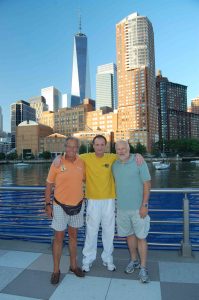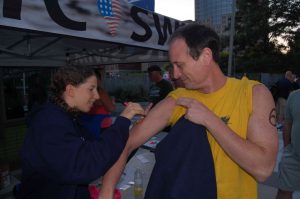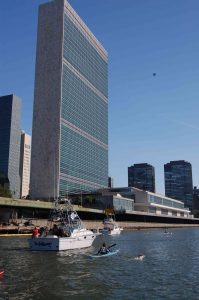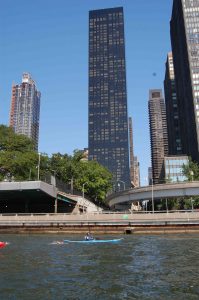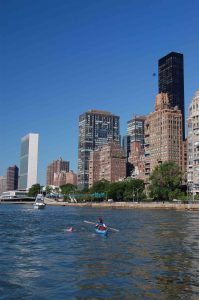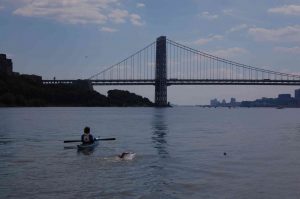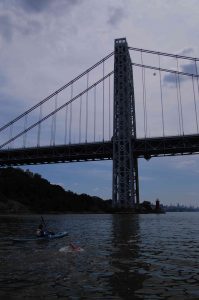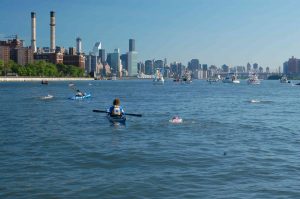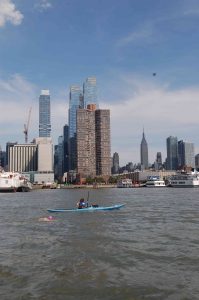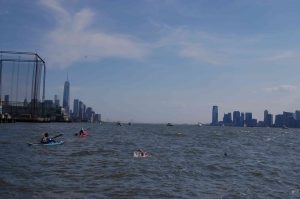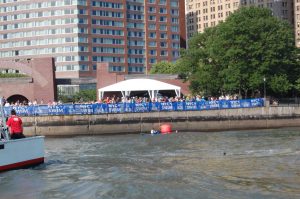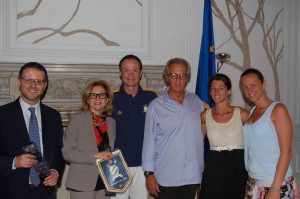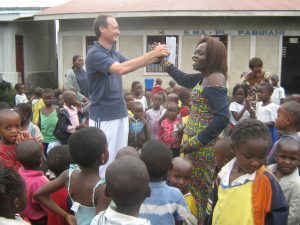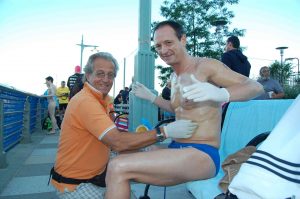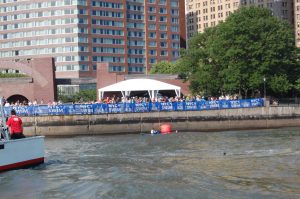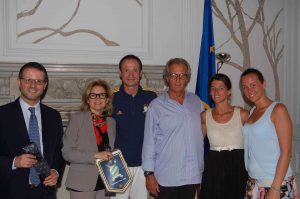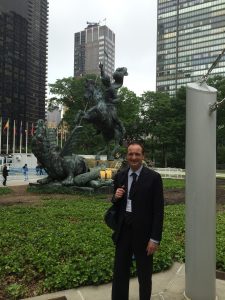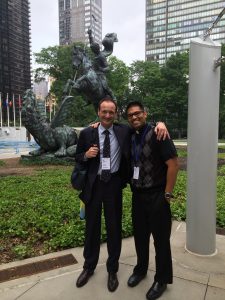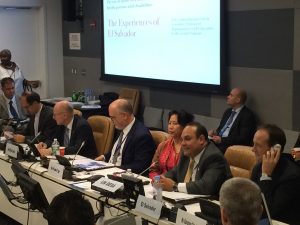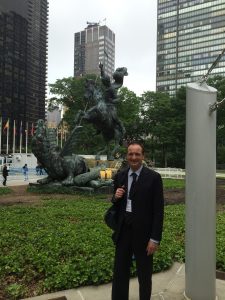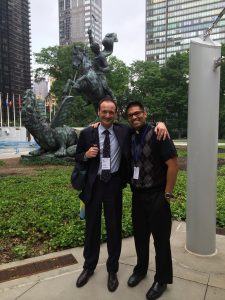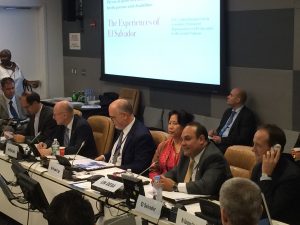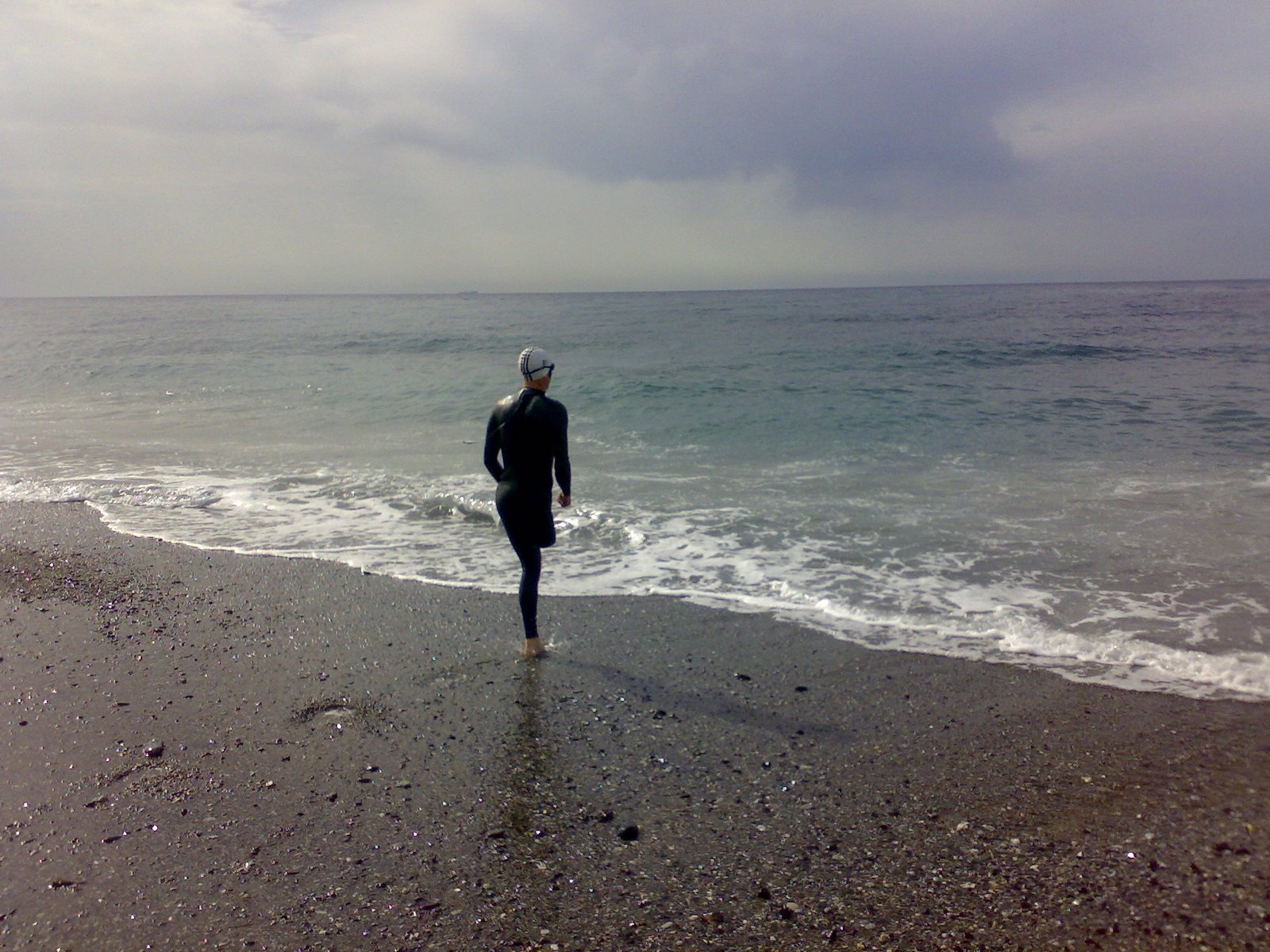Le staordinarie riprese della Manhattan Island Marathon Swim
alternate al mio intervento alle Nazioni Unite
mercoledì 16 luglio 2014
Manhattan Island Marathon Swim, la tappa finale
Vorrei esprimere la mia profonda gratitudine a quanti mi sono stati vicini con il loro affetto e il loro sostegno per tutti questi anni.
Voglio dire grazie a quanti hanno condiviso e continueranno – ne sono certo – a condividere la mia battaglia: per un mondo senza barriere e senza frontiere.
Un grazie particolare lo devo a quei giornalisti che – con la loro sensibilità – hanno fatto conoscere al mondo il mio progetto, come Valeria Robecco dell’ Ansa:
A nuoto nei mari del mondo con una sola gamba per sensibilizzare l’opinione pubblica sul tema della disabilita’:
Salvatore Cimmino, 50 enne originario di Torre Annunziata ma romano d’adozione, con le sue bracciate non vuole battere un record, ma portare avanti la sua sfida per un pianeta senza barriere e senza frontiere.
Il re delle maratone a stile libero ha concluso a New York il suo giro per i mari del globo:”E’ un progetto iniziato nel 2010 in Israele, e nato per abbattere tutte le barriere architettoniche e mentali che impediscono ancora oggi l’integrazione nella societa’ delle persone con disabilita’”, spiega all’ANSA dopo aver portato a termine con successo in 9 ore 34 minuti e 46 secondi la ‘Manhattan Island Marathon Swim’, una gara del periplo dell’isola di Manhattan di 54 km.
Un saluto particolare a tutte le persone incrociate lungo la strada che, senza conoscermi, hanno voluto regalarmi il loro tempo e la loro amicizia.
Ho iniziato questa avventura perché sono profondamente convinto dell’ importanza della condivisione. Solo portando all’attenzione dell’opinione pubblica le difficoltà e i disagi che quotidianamente vivono le Persone con Disabilità, solo sensibilizzando le coscienze, sarà possibile costruire, insieme, un mondo a misura di tutti.
Se condividiamo l’idea di una società che si faccia carico dell’altro e che invogli ognuno a mettere a disposizione dell’altro le proprie competenze e le proprie capacità, allora presto si potranno sconfiggere e abbattere definitivamente le barriere della diffidenza e dell’emarginazione e raggiungere obiettivi – fondamentali per noi disabili – come l’esigibilità delle leggi che regolano la disabilità, impedendo che oltre un miliardo di persone rimanga indietro, da sola, ad affrontare l’esistenza.
Oggi i Governi fanno ancora poco, e forse senza troppa consapevolezza e convinzione, in materia di disabilità;
dovrebbero invece iniziare ad occuparsene concretamente, affrontando la realtà dei disabili come problema da risolvere ma insieme anche individuando nel nostro mondo una importante e significativa risorsa da sfruttare per la crescita e lo sviluppo dei Paesi del mondo.
I Governi devono promuovere reali processi di integrazione, reali processi di cambiamento nell’organizzazione delle città, dei quartieri, dei trasporti, delle scuole, di tutte le strutture pubbliche.
Devono capire l’importanza strategica di una politica imprenditoriale che industrializzi gli enormi e straordinari passi avanti compiuti dalla ricerca scientifica e dallo sviluppo tecnologico per attuare quei processi che consentiranno ai disabile di fruirne appieno.
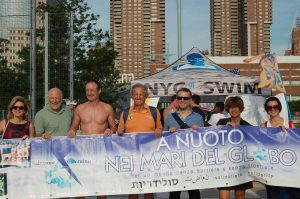
28 giugno 2014 - New York, Salvatore Cimmino tra
Natalia Quintavalle, Console Generale d'Italia e Roberto Frangione, Vice Console
Generale d'Italia
Rivoluzionare il sistema sanitario prevedendo investimenti maggiori, centri di ascolto per le famiglie, strutture accessibili. Facilitare l’ ingresso nel mondo del lavoro. Valorizzare di ogni cittadino le capacità e le attitudini e, soprattutto, non permettere mai che nessuno rimanga solo.
Le Persone con Disabilità devono collaborare e aiutare gli altri a vedere gli ostacoli che quotidianamente si presentano, dobbiamo impegnarci e non stancarci di parlare, manifestare, aiutare a dare voce a chi voce non può avere.
La mia prossima tappa – a novembre prossimo – si chiama Goma, città del Nord-Kivu, Repubblica Democratica del Congo, e il traguardo sarà quello di portare un aiuto concreto al Centro Protesi “Shirika la Umoja“, e per questo avrò bisogno, ancora una volta, di tanto sostegno e tanta solidarietà.
Salvatore Cimmino
Manhattan Island Marathon Swim, the final leg
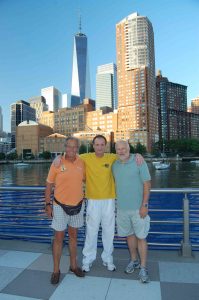
June 28th, 2014 - New York, Battery Park. Salvatore
Cimmino between Filippo Tassara and Michael Lenton
I would like to express my deep gratitude to all the people that have been close to me with their affect and support during these years.
I would also express my thanks to all those that shared and, I am sure, will continue to share my battle: for a world without barriers and borders.
My gratitude also to all the reporters that, thanks to their sensitivity, made to know my project to the world, such as Valeria Robecco from ANSA:
Swimming in the seas of the world with only one leg, in order to make public opinion sensitive to the subject of disability.
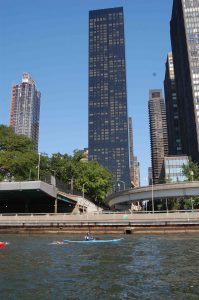
June 28th, 2014 - New York, swimming in front of the
headquarters of the Italian Mission to the United Nations
Salvatore Cimmino is a 50 years old man, originating from Torre Annunziata, but adopted by Rome; with his strokes is not trying to win a record, but to carry on his challenge for a world without barriers and borders.
The king of crawl marathons has concluded, in New York, his tour in the seas of the world: “It is a project that started in Israel in 2010 and was born to break all architectural and mental barriers, that still prevent the integration of disabled people in our society” explained after the successful conclusion of the ‘Manhattan Island Marathon Swim’, a 54 Km circumnavigations of the Manhattan Island, in 9 hours, 34 minutes and 46 seconds.
My special greetings to all the people met during the way that, without knowing, gave me their time and friendship. I started this adventure because I am deeply convinced about the importance of sharing.
Only bringing to the attention of public opinion the difficulties and troubles that are daily faced by the Disabled People, only if we sensitize the consciences, it will be possible to build, together, a world to dimension of all of us.
If we share the idea of a society that takes care of the others and stimulate everybody to make available to others their capabilities, then we shall be able to overcome and definitively break all the barriers of distrust and marginalization and achieve targets – that are primarily for us as Disabled – such as the chargeability of the laws that regulate the disability, preventing that more than a billion people could remain behind, to face their life alone.
Nowadays, the Governments are still doing very little, perhaps even without awareness and persuasion, on the matter of disability;
they should, on the contrary, start to take materially care about it, dealing with the reality of disabled people like a problem to be solved, and also looking at our world of Disabled people as an important and significant resource to exploit for the growth and development of the Countries of the World.
Governments should promote real integration processes, real changes in the organization of cities, districts, transports, schools and of all public organizations.
They must understand the importance of an entrepreneurship policy to industrialize the extraordinary steps forward, made by scientific research and technological development, in order to make effective those processes that will allow disables to fully enjoy them.
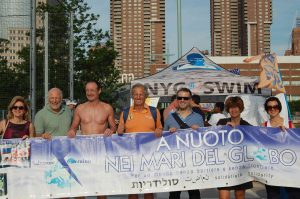
June 28th, 2014 - New York, Salvatore Cimmino between
Natalia Quintavalle, Consul General of Italy in New York and Roberto Frangione,
Vice Consul General of Italy in New York
Welfare system has to be radically changed, providing for higher investments, listening centers for families, easy to reach structures. Make access to work easier. Exploit capabilities and attitudes of each citizen e, moreover, never permit to leave somebody alone.
Disabled Peoples have to cooperate and assist the other people to understand the obstacles that they are daily facing; we must engage ourselves and never stop talking, communicating, assisting voiceless people to have their say.
Next step, within this year, is called Goma, a city in the North Kivu, Democratic Republic of Congo, and our target will be to bring a material aid to the Prothesis Center “Shirika la Umoja” and for this I will need, once more, a great support and solidarity
Salvatore Cimmino
LO SPORT COME STRUMENTO DI INCLUSIONE E SVILUPPO SOCIALE PER LE PERSONE CON DISABILITÀ
Introduzione:
Ci sono circa un miliardo di persone con disabilità nel mondo, pari al 15 per cento della popolazione mondiale. L’evidenza suggerisce che le persone con disabilità sono sproporzionatamente rappresentati tra i poveri del mondo. I bambini con disabilità hanno meno probabilità di frequentare la scuola, che a sua volta riduce le loro possibilità di sviluppo delle competenze per le future opportunità di integrazione. Questo tipo di esclusione, sia economica che sociale, viola i diritti umani della più grande minoranza del mondo e pone una grande sfida di sviluppo. Solo società ricche che sono veramente inclusive potranno contribuire a rafforzare il godimento dei diritti umani fondamentali e concorrere allo sviluppo di tutti i suoi membri.
Nazioni Unite, 10 Giugno 2014
Oggi mi trovo in un posto speciale, nel luogo delle buone intenzioni, dove ci si incontra a livello globale per ricercare insieme soluzioni ai problemi del pianeta e dei suoi abitanti.
E` un onore grandissimo quello di poter intervenire qui, portando la mia storia, nella speranza che anche una piccola esperienza possa contribuire al grande progetto delle Nazioni Unite.
Vivo da disabile dall`eta` di 14 anni, da quando, per salvarmi la vita, I medici decisero di amputarmi la gamba destra, molto in alto, quasi all`altezza dell`inguine. Gia` da questo si deduce quanto, all`epoca, fosse complicate e tardiva la diagnosi di osteosarcoma.
Una partita di pallacanestro tra adolescenti, un calcio, un dolore che non va via. Quindi una radiografia. La diagnosi fu talmente nefasta che I miei genitori, pur portandomi immediatamente a Bologna, all`ospedale Rizzoli, intimamente erano convinti di aver gia` perso un figlio.
Dopo l`operazione, lunga a quanto mi raccontano, non e` stato per niente facile recuperare una dimensione di normalita`. Sono seguiti anni di chemioterapie, sedute di fisioterapie nel Centro Inail di Budrio per imparare a camminare con la protesi, difficolta` infinite dal punto di vista psicologico.
Ero solo un ragazzino, colpito, in un momento cosi particolare dello sviluppo, da un dramma che le mie spalle, da sole, non riuscivano a sostenere.
In quel periodo ho imparato alcuni tra I valori che ancora mi accompagnano e che spero di riuscire a trasmettere alle persone che incontro: la solidarieta`, l`attenzione verso l`altro, la pazienza, la capacita` di accogliere le diversita` in uno spirito di crescita e arricchimento.
Li ho imparati proprio grazie alla mia famiglia, a tutti I medici, gli infermieri, I fisioterapisti che mi hanno accompagnato verso la guarigione.
Tutto cio` naturalmente mi ha molto aiutato ma non ha impedito che il mio percorso di vita sia stato a tratti molto faticoso perche`, fin da subito, ho capito che il mondo in cui viviamo e` spesso tagliato soltanto su misura delle persone perfettamente abili e sane.
Questa realta` pero`, invece di scoraggiarmi mi ha spinto, qualche anno fa, a mettermi in gioco per raccontare a quante piu` persone possibili la vita di un disabile, le sue difficolta`, le sue esigenze ma anche le sue potenzialita`, la sua voglia di partecipazione e d`integrazione.
E` nato un progetto che mi ha portato a nuotare in posti meravigliosi ma, soprattutto, mi ha fatto conoscere persone straordinarie e capaci, impegnate, con convinzione e generosita` enormi, nel tentativo di abbattere definitivamente quelle barriere, architettoniche e mentali, che impediscono al disabile un vero percorso di integrazione e partecipazione.
Sono convinto che sia indispensabile prendere atto che la realizzazione di una vera societa` democratica passa necessariamente attraverso l`inclusione totale e convinta di ogni individuo, al quale vanno offerte risorse e occasioni di crescita e sviluppo indipendentemente dalla sua condizione iniziale.
Questo per dire che il diversamente abile, l`handicappato, il disabile o comunque lo si voglia chiamare e`, innanzitutto, una persona che, nella sua diversita`, e proprio a partire da quella, ha bisogno di trovare risorse per una vita piena, soddisfacente e produttiva.
La vita dei disabili, la nostra vita, diversamente da quanto spesso si e` portati a credere, ha un senso ed uno scopo. Le difficolta` che incontriamo nel gestire la quotidianieta` sono spesso accresciute, se non create, da un problema di tipo culturale che condiziona le relazioni tra disabili e normodotati creando una distanza che impedisce l`integrazione.
I giovani disabili, in particolare, si trovano a dover risolvere, oltre ai problemi di tipo pratico derivanti dal loro specifico problema, anche un enorme groviglio psicologico che e` tipico dell`eta` adolescenziale ma che viene amplificato dall`incapacita` di gestire una diversita` vissuta come un impedimento, ingiusto e doloroso, ad una vita piena e serena.
E` necessario pero`, soprattutto pensando ai ragazzi, arrivare a capire che la disabilita` puo` se non completamente annullarsi diventare, in alcuni casi, molto piu` facilmente gestibile. Questo grazie ad una serie di fattori tutti ugualmente importanti: penso agli aiuti alle famiglie, a politiche inclusive dal punto di vista lavorativo, ad un intervento culturale che iniziando dalla scuola finisca per pervadere l`intera societa`, a risorse economiche da destinarsi specificatamente all`abbattimento definitivo, ovunque, delle barriere architettoniche, ad interventi diretti e convinti nei paesi in via di sviluppo dove la disabilita` e` spesso figlia delle guerre e di un`insufficiente, se non completamente assente, assistenza sanitaria.
E poi penso agli enormi e straordinari passi avanti compiuti dalla ricerca scientifica e dallo sviluppo tecnologico e alla necessita` di attuare quei processi che consentano a tutti I disabili di poterne fruire. Mi riferisco soprattutto della tecnologia applicata ai dispositivi protesici, che mi riguarda direttamente, ma parlo anche del contributo portato dall`ingegneria alla medicina che ha reso possibile, per esempio, la produzione di dispositivi poco invasivi per il rilascio mirato dei farmaci o per il controllo di protesi sempre piu` complesse, come nel caso del cuore artificiale.

10 Giugno 2014 - Nazioni Unite, New York - Michael
Lenton, Salvatore Cimmino, Alfredo Ferrante, Eugenio Guglielmelli
Una cosa importante, che ho capito con il passare degli anni, e` che non si puo` combattere contro una condizione definitiva, bisogna invece in qualche modo assecondarla individuando e potenziando tutte quelle competenze che sono ancora presenti. Lo dico perche` noi disabili, lo sport, in questa direzione, puo` offrire un contributo assolutamente fondamentale.
Lo sport ha significati ed effetti che trascendono il benessere fisico intervenendo, nel caso di un disagio mentale, anche sullo sviluppo delle capacita` logiche ed intellettive e, in ogni caso, facilitando I processi di inclusione e socializzazione perche` rende possibili, anche attraverso l`aspetto ludico, esperienze di relazioni che altrimenti rischierebbero di rimanere precluse.
Sono convinto che tutti I giovani, normodotati e disabili, potrebbero trovare nello sport un punto di confronto utile ed avviare un processo di cambiamento vero e profondo nella societa`, un processo che contempli finalmente parole come integrazione e inclusione e che valorizzi le differenze e consenta a tutti di contribuire ad uno sviluppo diverso di questo nostro pianeta, uno sviluppo che non lasci ne` indietro ne` fuori piu` nessuno.
Nuotando provo sensazioni straordinarie, torno ad avere tutte e due le gambe, torno a correre, non ho impedimenti ne` fisici ne` mentali.
Vorrei che nel mondo tutti potessero correre insieme.
Grazie per avermi ascoltato, grazie alla Missione Permanente Italiana, grazie a tutti.
Salvatore Cimmino
SPORTS FOR INCLUSIVE DEVELOPMENT AND EMPOWEREMENT FOR PERSONS WITH DISABILITIES
Introduction:
There are approximately one billion persons with disabilities in the world, amounting to 15 percent of the global population. Evidence suggests that persons with disabilities are disproportionately represented among the world’s poor. Children with disabilities are less likely to attend school, which in turn decreases their chances of developing skills for future employment opportunities. This kind of exclusion, both economic and social, breaches the human rights fo the world’s largest minority and poses a major development challenge. Rich diverse societies that are truly inclusive will help strengthen the enjoyment of fundamental human rights and contribute to development for all its members.
Here is a talk given by Salvatore Cimmino on June 10, 2014 at the United Nations in New York, USA.
Today I find myself in a special place, a place of good will, where people meet at the global level to find solutions to the problems afflicting the planet and its inhabitants.
It is a great honor to be able to speak here today to bring you my story in the hope that even this small life experience can contribute to the universal vision of the United Nations.
I have been disabled since I was fourteen, when to save my life, my doctors decided they had to amputate my right leg, very high up, almost at the height of my groin. This alone tells you how, at the time, the diagnosis of osteosarcoma was complicated and delayed.
While playing basketball with my friends, there was a kick, followed by a pain that would not go away – then an x-ray. The diagnosis was so devastating that my parents, despite taking me immediately to the Rizzoli hospital in Bologna, intimately felt that they had already lost a son.
After the operation, which they say took long, it was very hard for me to get back to some form of normalcy. It took me years of chemotherapy, sessions with the physical therapists at the local healthcare center of Budrio to learn how to walk with prosthesis, which was extremely difficult psychologically.
I was just a kid, struck, at a very delicate stage of development, by a tragedy that my shoulders alone could not bear.
At that time I learned some of the values that I still carry with me today and that I hope to be able to instill in the persons that I meet: solidarity; attention to others; patience; the capability of embracing diversity in a spirit of mutual growth and enrichment.
I learned these values from my family, all of my doctors, nurses, physical therapists who have accompanied me along my path toward healing.
All of this has certainly helped me, but it did not make my life any less challenging, because early on I learned that the world in which we live in is often tailor-made only for people who are perfectly able-bodied and sound.
This, however, instead of discouraging me, actually pushed me a few years ago to put myself out there and tell as many people as possible what the life of a disabled person is like, what are the difficulties and needs, but also what are the disabled person’s potential, and will to participate and be integrated in society.
We launched a project that has brought me to swim in some of the most beautiful places in the world. More importantly, however, this project has allowed me to meet extraordinary and capable people committed to, with enormous faith and generosity, definitively breaking down those architectural and mental barriers that hamper the disabled person’s path toward integration and participation.
I firmly believe that we must acknowledge the fact that for a true democratic society to be realized, it must necessarily be built on total and unyielding inclusion of every individual, to which to offer resources and opportunities for growth and development independently of their initial condition.
This is to say that the “diversely able”, the “handicapped”, the “disabled” or whatever other term we’d like to use, is, first and foremost, a human being, who because his or her diversity, and perhaps by virtue of it, needs to have resources available for a full, fulfilling and productive life.
The lives of the disabled, our lives, unlike what most people may think, have a sense and have a purpose. The difficulties we encounter in managing our everyday life are often heightened, if not created, by a cultural problem that impacts relations between the disabled and the able-bodied creating a distance that impedes integration.
Young disabled persons, in particular, find themselves, besides dealing with the practical issues deriving from their specific physical problem, grappling also with enormous psychological upheavals that are typical of adolescence but which are amplified by the inability to accept their diversity as they see it as an unfair and painful impediment to a full, beautiful life.
When it comes to youths in particular, we must help understand that a disability, if not completely made up for, can, in some cases, be much more easily manageable.
This is owed to a series of factors that are all equally important: I’m referring to the help of parents; to inclusive employment policies; to cultural initiatives that, starting with schools, can be mainstreamed into the entire society, to financial resources channeled specifically toward definitively eliminating architectural barriers everywhere, and to direct, bold intervention in developing countries where disability is often caused by war and healthcare is inadequate, when not completely absent.
Then I think about the enormous extraordinary advances made in scientific research and technology and the need to put in motion those processes that will allow all disabled persons to use them.
I am referring namely to applied technologies for prosthetic devices, which could be suitable for me, but also to the contribution engineering has made to medicine, which in turn has made possible, for example, the production of scarcely invasive devices for the administration of medicine or for the adjustment of ever more sophisticated prostheses, as is the case of the artificial heart.

June 10, 2014 - United Nations, New York - Michael
Lenton, Salvatore Cimmino, Alfredo Ferrante, Eugenio Guglielmelli
An important thing that I learned through the years is that you cannot fight against a permanent condition, you must, instead, find a way to accept it, identifying and exalting those abilities that you do have.
I say this because for us disabled persons, sport can be extremely helpful in this sense.
Sport carries meaning and effects that go beyond physical wellbeing. For example, in the case of mental disability, sport can impact logical and intellectual reasoning, and always facilitates inclusion and socialization because it creates, even through recreational activities, experiences and relations that otherwise would be unattainable.
I truly believe that all young people, whether disabled or able-bodied, could find through sport a meeting point from which to start a process of authentic and radical change of society; a process that would finally comprise words like integration and inclusion and that values differences and allows for everyone to contribute to a different way to develop our world, a way that no longer leaves anyone “out” or “behind”.
When I swim I feel the most extraordinary sensations, I am whole again with both my legs; I am running and have no hindrances – neither physical nor mental.
My wish is that in this world we can all run together.
Thank you for you attention, thank you to the Permanent Mission of Italy, thank you all.
Salvatore Cimmino
Iscriviti a:
Commenti (Atom)
